CAA News Today
US Patents and Trademarks Office Issues “Green Paper” on Copyright in the Digital Age
posted by CAA — August 30, 2013
The following text is from a blog post by Shira Perlmutter, director of the United States Patents and Trademarks Office (USPTO).
We Want to Hear from You on Copyright Policies in the Digital Economy
The Department of Commerce’s Internet Policy Task Force (IPTF) last week issued a green paper on copyright, and I’d like to take a moment to highlight the paper’s core content and goals. The paper, titled Copyright Policy, Creativity, and Innovation in the Digital Economy (Green Paper), represents the most thorough and comprehensive analysis of digital copyright policy issued by any administration since 1995. Along with the National Telecommunications and Information Administration (NTIA), the USPTO played a key role in its production, from gathering public comments starting in 2010 through the paper’s drafting and release.
The Green Paper calls for new public input on critical policy issues that are central to our nation’s economic growth, cultural development, and job creation. It is intended to serve as a reference for stakeholders, a blueprint for further action, and a contribution to global copyright debates. As promised in the paper, we will soon be reaching out to the public for views on a variety of topics. Please stay tuned for announcements about how to share your thoughts, insights, and recommendations.
STAFF SPOTLIGHT: ALAN GILBERT
posted by Christopher Howard — August 29, 2013
Alan Gilbert in Marfa, Texas
Alan Gilbert (photograph by Nina Subin)
A poet and a critic, Alan Gilbert has been staff editor of caa.reviews since 2005. He recently spent three weeks in Marfa, Texas, as a Lannan Foundation writer-in-residence. Gilbert is the author of the poetry books The Treatment of Monuments (2012) and Late in the Antenna Fields (2011), as well as a collection of writings on contemporary poetry and art entitled Another Future: Poetry and Art in a Postmodern Twilight (2006). CAA spoke with him recently about his residency experience.
How did the Lannan Foundation residency come about?
The residency is by nomination only, and I was thrilled to receive an email back in January saying I could come any time during the next year for up to eight weeks. I ended up choosing the first three weeks in July.
What did you work on during your residency?
I was able to finish a new manuscript of poems and prepare it to send out to potential publishers.
How does Marfa compare to New York and did it have an effect of your work?
The primary thing I noticed about Marfa was the silence. There are quieter parts of New York, but it’s still difficult to avoid the sounds of sirens, buses, car horns, stereos, neighbors, et cetera. My house and street in Marfa were incredibly quiet. Some afternoons, a car wouldn’t drive by for hours. I’m not sure of the effect it had on my work, but the effect it had on my psyche and physiology felt transformative, especially after living in New York for fifteen years. More mundanely, I had extended, uninterrupted time to write, which can be harder and harder to find.
Did you come to art from poetry? If so, why?
I did come to art from poetry, but I came to both poetry and art from a larger history of the twentieth-century avant-garde, whether literature, art, music, or film. (Stan Brakhage was one of my teachers when I was an undergraduate.) Also, the current critical discourse around contemporary visual art is much more advanced than the one around poetry, and so I was intrigued to figure out what I could learn from it and take back to poetry and other art forms.
How did your reading at the Marfa Book Company on July 13 go?
It was great. It was part of the series of readings given by Lannan residents, and so the audience has an informed and wide-ranging knowledge of contemporary writing. For example, the writer who read two weeks before me was the acclaimed novelist Colson Whitehead.
What was the sense of community, if any, at Marfa? Did you collaborate with anyone or make new contacts?
In fact, the best thing about Marfa is precisely this sense of community. Otherwise, it’s just a tiny, fairly impoverished town (pop. 2,000) in the West Texas desert, three hours from the nearest major airport in El Paso. Of course it also has some great art. The Marfa Book Company owner, Tim Johnson, is incredibly energetic and supportive and widely loved. His partner, Caitlin Murray, who works at the Judd Foundation in Marfa and writes about Donald Judd and his contemporaries, is wonderful. Fairfax Dorn, who cofounded Ballroom Marfa, has an expansive vision for art. Hamilton Fish V, who helped revive The Nation in the 1970s and is a film producer and much more, has a house there. He was great to talk to. There are easily a half dozen other inspired people I could name and spent time with.
What are your future publishing plans?
To find a publisher for the manuscript of poems I finished.
News from the Art and Academic Worlds
posted by Christopher Howard — August 28, 2013
Each week CAA News publishes summaries of eight articles, published around the web, that CAA members may find interesting and useful in their professional and creative lives.
Nineteen Lessons about Teaching
1. Teaching is a learning experience. Every time I teach a lesson, I learn the material in new and deeper way. I also always learn so much from my students. I learn from their own life experiences. I learn from their insights and reactions. They see aspects all the time in the sources we use that I wouldn’t have seen otherwise—and these are awesome teaching moments. (Read more from Inside Higher Ed.)
New Infographic: Good News in Fair Use for Libraries
A new infographic from the Association of Research Libraries tells the story of library fair use and the Code of Best Practices in a clear and compelling way. There’s an embeddable PNG for your own blogs, and there’s also a print-ready 8½ x 11 inch version in case you need hardcopies to hand out at events. (Read more in ARL Policy Notes.)
Building Digital Humanities Projects for Everyone
Earlier this summer, the American Historical Association profiled a few recipients of National Endowment for the Humanities start-up grants to see what kinds of projects were emerging from the world of digital humanities with particular applications for historians. This month the organization caught up with a new cohort of implementation grantees, recently announced by the NEH Office of Digital Humanities. (Read more from the American Historical Association.)
Van Gogh in 3D? A Replica Could Be Yours for £22,000
A poster of one of Van Gogh’s sunflowers is one of the traditional adornments to a student bedroom. The rest of us hang our reproductions with the knowledge that even the good ones are far from faithful to the originals—for which the going rate is £24 million. But not anymore. The Van Gogh museum in Amsterdam has developed high-quality 3D reproductions of some of its finest paintings, with what it describes as the most advanced copying technique ever seen. (Read more in the Guardian.)
The Real Neuroscience of Creativity
You know how the left brain is realistic, analytical, practical, organized, and logical, and the right brain is creative, passionate, sensual, tasteful, colorful, vivid, and poetic? Thoughtful cognitive neuroscientists such as Rex Jung, Darya Zabelina, Andreas Fink, and others are on the forefront of investigating what actually happens in the brain during the creative process. And their findings are overturning conventional notions surrounding the neuroscience of creativity. (Read more in Scientific America.)
The Benefits of Flipping Your Classroom
A small but growing number of faculty at major universities are experimenting with the inverted or flipped classroom. It’s an instructional model popularized by, among other influences, a Ted Talk by the Khan Academy founder Salman Khan, which has received more than 2.5 million views. Institutions as varied as Duke University’s School of Medicine, Boston University’s College of Engineering, and the University of Washington School of Business are experimenting with changing from in-class lectures to video lectures and using class time to explore the challenging and more difficult aspects of course content. (Read more from Faculty Focus.)
Another Digital Divide
More students are being disciplined for sharing incendiary remarks through social media, drawing outraged responses from peers who say online interactions don’t dictate offline behavior. Despite the conflicting ideas of how students should behave on the internet, social-media etiquette is almost never discussed during first-year orientation. (Read more from Inside Higher Ed.)
Do Critics Paint Women Artists Out of the Picture?
Is there a glass ceiling for women in the arts? A glance by a visiting alien would see twenty-first-century Britain as one of the best places and times ever for women working as artists. I went to Rome for my holidays and gorged on paintings, frescoes, and statues, from ancient Roman mosaics to Canova nudes. None of these great works of art of ages gone by is credited to a woman—which doesn’t mean there were no women artists at all before modern times. (Read more in the Guardian.)
Extended Deadline for 2015 Annual Conference Session Proposals
posted by Emmanuel Lemakis — August 27, 2013
 CAA invites individual members to propose a session for the 103rd Annual Conference, taking place February 11–14, 2015, in New York. Proposals should cover the breadth of current thought and research in visual art, art and architectural history, theory and criticism, pedagogical issues, museum and curatorial practice, conservation, and developments in technology. For full details on the submission process for the conference, please review the information published on the Chair a 2015 Annual Conference Session webpage.
CAA invites individual members to propose a session for the 103rd Annual Conference, taking place February 11–14, 2015, in New York. Proposals should cover the breadth of current thought and research in visual art, art and architectural history, theory and criticism, pedagogical issues, museum and curatorial practice, conservation, and developments in technology. For full details on the submission process for the conference, please review the information published on the Chair a 2015 Annual Conference Session webpage.
The Annual Conference Committee welcomes session proposals from established artists and scholars, along with those from younger scholars, emerging and midcareer artists, and graduate students. Particularly welcome are proposals that highlight interdisciplinary work. Artists are especially encouraged to propose sessions appropriate to dialogue and information exchange relevant to artists.
The submission process for the 2015 conference is now open. In order to submit a proposal, you must be a current CAA member. Deadline extended to Tuesday, September 10, 2013.
Image Caption
A. Major, Bird’s-Eye View of the Great New York and Brooklyn Bridge, and Grand Display of Fireworks on Opening Night … May 24, 1883, 1883, color lithograph, 18⅞ x 26¼ in. Metropolitan Museum of Art, New York (artwork in the public domain).
John Greyson Arrest in Egypt
posted by Linda Downs — August 27, 2013
The College Art Association joins colleagues around the world in expressing its hope for the swift release of John Greyson, Associate Professor at York University and Director of York’s graduate program in film, who was recently detained in Egypt, together with Tarek Loubani, a physician, while working on a film project. More information about John Greyson’s arrest has been provided by his home institution, York University: http://news.yorku.ca/2013/08/19/statement-from-york-university-president-and-vice-chancellor-mamdouh-shoukri-on-professor-john-greyson/.
Further information regarding the campaign to free John Greyson, can be found here:
http://www.podur.org/node/1019
Messages of support seeking his release can be directed to the following authorities:
Canadian Embassy in Egypt: cairo@dfait-maeci.gc.ca
Egyptian Embassy, Ottawa, Canada
Phone:
+1-613-234-4931
+1-613-234-4935
Email:
egyptemb@sympatico.ca
Egyptian Consulate General, Montreal, Canada
Phone:
+1-514-8668455
+1-514-8668456
+1-514-8668457
Email:
egypt.consulate@videotron.ca
John Baird – Minister of Foreign Affairs Canada
Phone
613-990-7720
Email
bairdj@parl.gc.ca
Twitter: John Baird @honjohnbaird
Twitter: Department of Foreign Affairs Canada: @DFATDCanada
Stephen Harper – Prime Minister of Canada
Phone [Ottawa office]
613-992-4211
Email
stephen.harper@parl.gc.ca
For the US:
Egyptian Embassy in the US: embassy@egyptembassy.net
Petition to Prevent the Sale of Works from the Detroit Institute of Arts
posted by CAA — August 26, 2013
The Executive Committee of the CAA Board of Directors has agreed to promote this petition, initiated by Jeffrey Hamburger of Harvard University, regarding the potential sale of the collection of the Detroit Institute of Arts.
On May 28, 2013, CAA published an open letter to Kevyn Orr, emergency manager of the city of Detroit, to express concern over the future of the museum’s excellent collection of visual art.
Solo Exhibitions by Artist Members
posted by CAA — August 22, 2013
See when and where CAA members are exhibiting their art, and view images of their work.
Solo Exhibitions by Artist Members is published every two months: in February, April, June, August, October, and December. To learn more about submitting a listing, please follow the instructions on the main Member News page.
August 2013
Abroad
Grimanesa Amorós. Museum of China Central Academy of Fine Arts, Beijing, China, June 2–22, 2013. The Mirror Connection. Light sculptural installation.
Julie Langsam. Espai-8, Barcelona, Spain, March 20–April 17, 2013. Buildings and Blueprints. Acrylic on wall.
Stephen McClymont. Galry, Paris, France. September 15–October 15 2013. Bouquet. Painting.
Mid-Atlantic
Lee Arnold. Montclair Art Museum, Montclair, New Jersey, April 3–September 15, 2013. Works by Lee Arnold. Digital video.
Anne Massoni. Print Center, Philadelphia, Pennsylvania, January 11–March 16, 2013. Anne Massoni: Holding. Photography.
Sharon Wolpoff. Woman’s National Democratic Club, Washington, DC, May 29–September 3, 2013. In the Early Bright. Oil painting.
Northeast
Lorrie Fredette. Garrison Art Center, Garrison, New York, August 10–September 8, 2013. Implementation of Adaptation. Installation.
Kate Gilmore. Institute of Contemporary Art, Maine College of Art, Portland, Maine, July 3–August 4, 2013. Kate Gilmore. Video and performance.
Julie Langsam. 532 Gallery Thomas Jaeckel, New York, April 11–May 25, 2013. Now(here). Oil painting.
Jerry Meyer. Denise Bibro Fine Art, New York, May 16–July 6, 2013. Ordinary Unhappiness. Multimedia light boxes and installation.
John Morrell. Atlantic Gallery, New York, May 28–June 21. Domestic Landscapes. Painting and drawing.
Linda Stein. Romany Kramoris Gallery, Sag Harbor, New York, June 27–September 2, 2013. Power and Protection: Bully Proof Vests by Linda Stein. Sculpture.
Jayoung Yoon. Here Arts Center, New York, July 18–August 17, 2013. Mind Out of Time. Sculpture, video, and performance.
South
Linda Stein. Fine Arts Gallery, St. Edward’s University, Austin, Texas, September 5–27, 2013. The Fluidity of Gender: Sculpture by Linda Stein. Sculpture.
West
Mara De Luca. Quint Contemporary Art, La Jolla, California, June 8–July 27, 2013. Even If the Lights Go Out. Painting.
Carol Ladewig, Slate Contemporary, Oakland, California, February 28–March 23, 2013. Year in Color/Lunar Cycles: New Work by Carol Ladewig. Acrylic and gouache on panels and on canvas and digital prints.
Recent Deaths in the Arts
posted by Christopher Howard — August 22, 2013
In its regular roundup of obituaries, CAA recognizes the lives and achievements of the following artists, historians, educators, and others whose work has significantly influenced the visual arts. Notable deaths this summer include four major internationally known artists: Ruth Asawa, Walter De Maria, León Ferrari, and Allan Sekula. In addition, CAA has published special obituaries on the Asian American art historian Sadayoshi “Sada” Omoto and the eminent Russian scholar Dmitrii V. Sarabianov.
- Ruth Asawa, an artist based in San Francisco who created abstract sculpture, including intricate hanging wire pieces and several public fountains, passed away on August 6, 2013. She was 87 years old
- Ronnie Cutrone, an artist and an assistant to Andy Warhol in the Factory from 1972 into the early 1980s, died on July 21, 2013. He was 65
- Walter De Maria, a sculptor best known for his large-scale outdoor work The Lightning Field and indoor pieces such as The New York Earth Room and The Broken Kilometer, died on July 25, 2013. He was 77 years old
- León Ferrari, an Argentine artist known for provocative work that addressed war, religion, power, and sex, died on July 25, 2013. He was 92 years old
- Betty Jones, a conservator of paintings at Harvard University’s Fogg Museum and for the Museum of Fine Arts, Boston, died on May 20, 2013, at age 94. She was instrumental in recovery efforts in Venice after the city was flooded in 1966
- Ben Lifson, a writer, curator, and photographer, passed away on July 3, 2013, at the age of 72. Lifson served as photography critic for the Village Voice from 1977 to 1982
- Larry Nowlan, a realist sculptor based in New Hampshire known for his bronze statue of the actor Jackie Gleason as Ralph Kramden, sited outside New York’s Port Authority, died on July 30, 2013. He was 48 years old
- Sadayoshi “Sada” Omoto, a historian of American and Asian art who taught at Michigan State University for thirty-three years, died on March 4, 2013, at the age of 90. A special obituary on the scholar has been published by CAA
- John Reilly, the founder of a New York theater for underground video called the Global Village, died on July 28, 2013, age 74. Reilly financed documentary films and created his own, including Waiting for Beckett (1993), while also teaching workshops on video production
- Alejandro Santiago, a Mexican artist who worked on a series of small statues called 2501 Migrantes from 2002 to 2008, passed away on July 22, 2013. He was 49 years old
- Dmitrii V. Sarabianov, a Russian scholar who specialized in art of the nineteenth and twentieth centuries, passed away on July 19, 2013, age 89. CAA has published a special obituary on the eminent art historian
- Allan Sekula, an artist, photographer, writer, and longtime professor at California Institute of the Arts, died on August 10, 2013. He was 62 years old. Last year CAA honored Sekula with its Distinguished Lifetime Achievement Award for Writing on Art
- Jud Yalkut, a film and video artist based in Dayton, Ohio, died on July 23, 2013, at the age of 75. He founded the film and video program at Wright State University in 1973 and also taught at Sinclair Community College and Xavier University
Read all past obituaries in the arts in CAA News, which include special texts written for CAA. Please send links to published obituaries, or your completed texts, to Christopher Howard, CAA managing editor, for the next list.
Sadayoshi “Sada” Omoto: In Memoriam
posted by CAA — August 21, 2013
adayoshi “Sada” Omoto: In Memoriam
The following obituary was prepared by the deceased’s wife, Kathryn B. Omoto, and his son, Loren Omoto.

Sadayoshi Omoto
Sadayoshi “Sada” Omoto, an artist and art historian, died on March 4, 2013, after a lifetime of inspiring students, artists, and friends. He was 90 years old. Omoto’s path through life brought him challenges, opportunities, and triumphs. He was a beloved husband, father, grandfather, college professor, elected official, activist and, in later years, an artist. His indomitable spirit and easygoing personality made him a friend to and role model for many. His individuality and dogged determination emerged early and were defining characteristics throughout his life.
Omoto was born at Wing Point on Bainbridge Island, Washington. The island—a short ferry ride from Seattle—was an idyllic spot to grow up. As a young man he began classes at the University of Washington, but his life was changed forever on the day Japanese forces attacked Pearl Harbor. Soon after, President Franklin Delano Roosevelt signed Executive Order 9066 authorizing the United States military to relocate American citizens of Japanese ancestry from the West Coast. The first people subject to the evacuation order were Japanese Americans living on Bainbridge Island.
Omoto’s family and more than two hundred other island residents were given just six days to collect what possessions they could carry and make arrangements for their property. On March 30, 1942, US soldiers carrying rifles with bayonets rounded them up and put them on a ferry to Seattle. Ultimately the family became some of the first residents at Manzanar War Relocation Center, an internment camp located in a remote area of the Southern Californian desert. At Manzanar, Omoto lived in communal barracks with his brother and widowed mother, surrounded by barbed wire, dogs, and guard towers, while his two older brothers served in the US military. The experience instilled a keen awareness of social injustice. He later made his forced relocation a “teachable moment” for his children and for hundreds of others who heard him speak or who viewed his highly personal art on the subject.
Omoto left the camp to join the US Army, training as a linguist at the Military Intelligence Service Language School in Minnesota. He made his first journey to Asia while in the military. After the war, Omoto resumed his quest for a higher education—but this time in the Midwest. Omoto enrolled at Oberlin College in Ohio and earned a bachelor’s degree. He also earned a master’s degree from Michigan State University and his PhD in art history from Ohio State University.
For the next forty years, Omoto taught American and Asian art history—first at Bradley College in Illinois, then at Wayne State University in Detroit, and finally at Michigan State, where he worked for thirty-three years. During his career, he served as department chair and as advisor to a minority student organization. His concern and attention to principles of justice were remembered by students long after their college careers.
Omoto was the author of numerous articles in professional journals, including “Thackeray and Architectural Taste” (1967) and “The Queen Anne Style and Architectural Criticism” (1964) in the Journal of the Society of Architectural Historians; “The Sketchbooks of Worthington Whittredge” in Art Journal (1965); and “Berkley and Whittredge at Newport” in Art Quarterly (1964). He also wrote book reviews and contributed articles to the Kresge Art Center Bulletin.

Under the auspices of the Bicentennial Inventory of American Paintings Executed before 1914, a program of the National Collection of Fine Arts (later renamed the Smithsonian American Art Museum), Omoto directed the inventory of early Michigan paintings. The collection of over one thousand works served as the basis for the Michigan Experience exhibition at Kresge Art Center Gallery at Michigan State in 1986, which traveled to venues throughout the state. He authored exhibition catalogues for The Michigan Experience (1986, with Eldon Van Liere) and Early Michigan Paintings (1976–77).
After retiring from Michigan State, Omoto returned to the northern Michigan community he had first visited as an art student during the 1950s. In Leland, he cultivated a new life focused on creativity and community service. He attended painting classes and helped to form a collective of local artists who drew inspiration from the local landscape and from each other. Omoto also helped to organize exercise classes for seniors and exhibitions of art from the past and present. With his wife Kathryn, he supported the work of the Leelanau Conservancy and other local historic-preservation efforts. Although slowed in recent years, Omoto remained a familiar sight at Leland community events, galleries, and coffee shops. His gentle humor and easy smile made him a beacon of friendliness during any season.
Omoto is survived by his wife, Kathryn Bishop Omoto; his children Allen Omoto (David Robinson) of Claremont, California, Katherine (Neal) Fortin of Okemos, Michigan, Loren (Susan) Omoto of Maitland, Florida; his granddaughter Helen Fortin of Okemos; and numerous nieces and nephews. Omoto was preceded in death by his parents Daikichi and Masa Omoto; his son Roger Omoto; his brothers Masakatsu, Setsuo, and Taketo Omoto; and his sister Kanee Omoto.
Dmitrii V. Sarabianov: In Memoriam
posted by CAA — August 21, 2013
Alison Hilton is Wright Family Professor of Art History at Georgetown University in Washington, DC.
Dmitrii V. Sarabianov, a Russian art historian and a specialist on nineteenth- and twentieth-century art, died in Moscow on July 19, 2013. He was 89 years old. Sarabianov was one of the great art historians of his generation, those who began their scholarly careers during and following World War II.
Born on October 10, 1923, into the family of a Marxist philosopher, Sarabianov showed an early interest in the arts, especially poetry and music, as well as camping and athletics. Soon after he began his undergraduate studies in 1941, Germany invaded the Soviet Union. He joined the army to serve as a translator, was wounded twice, and received several medals for military merit. After the war Sarabianov completed his undergraduate work at Moscow State University and was admitted into the school’s graduate program in art history, earning his candidate’s degree in 1952.
In 1954 he began work at Moscow’s prestigious Institute of Art History, first as a senior researcher and later as deputy director. From 1966 to 1996 Sarabianov taught and served as the head of the Art History Department at Moscow State University. He earned his doctorate in 1971. (In Russia this signifies substantial scholarly achievement beyond the candidate’s degree; it is roughly equivalent to full professorship.) Sarabianov became a corresponding member of the Russian Academy of Sciences in 1987 and was elected to the rank of academician five years later.
Sarabianov was an inspiring teacher and mentor whose influence guided the careers of many Russian academics and museum scholars for several generations. Even for those who did not encounter him directly, Sarabianov’s publications—numbering more than 360 books and articles—set a standard for scholarship recognized both in Russia and abroad. Subjects of his monographs, many of them translated, include important nineteenth-century artists, among them Pavel Fedotov, Orest Kiprenskii, Aleksei Venetsianov, Ilya Repin, and Valentin Serov, as well as key figures in early-twentieth-century art such as Vasilii Kandinsky, Pavel Kuznetsov, Robert Falk, Liubov Popova, and Kazimir Malevich. What distinguishes Sarabianov’s work is the scope and originality of his interpretations of Russian art movements. He was among the first to write about Russian nineteenth-century painting in relation to European art, and he published a path-breaking study of international Art Nouveau in 1989. His book Russian Art: From Neoclassicism to the Avant Garde 1800–1917 (1990) is considered the fundamental text on the subject.
Sarabianov always took his civic responsibility as an academic very seriously. He spoke up at meetings, defended intellectual freedom, and voted on policy questions. In 2005, he and colleagues in Moscow’s major museums and other art institutions created the National Organization of Art Experts (NOEXI) to monitor and cope with the unprecedented demands of the chaotic art market in Russia and to establish means of ensuring professional credibility and trust.
Regarded by his peers, his former students, and his readers as a scholar of absolute integrity, Dmitrii Sarabianov will be missed most for his immense charm and kindness. He is survived by his wife, Elena Borisovna Murina, and his sons, Andrei and Vladimir Sarabianov.




 Grimanesa Amorós, The Mirror Connection, 2013, light-emitting diodes, diffusion material, reflective material, custom lighting sequence, and electrical hardware, 30 x 20 x 33 ft. (artwork © Grimanesa Amorós)
Grimanesa Amorós, The Mirror Connection, 2013, light-emitting diodes, diffusion material, reflective material, custom lighting sequence, and electrical hardware, 30 x 20 x 33 ft. (artwork © Grimanesa Amorós)
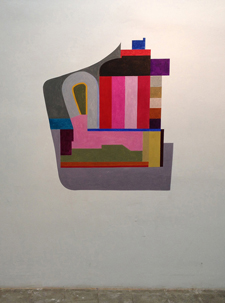 Julie Langsam, Sert Floorplan: Spanish Pavilion, Color Determined by Chance, 2013, acrylic on wall, 7 x 8 ft. (artwork © Julie Langsam)
Julie Langsam, Sert Floorplan: Spanish Pavilion, Color Determined by Chance, 2013, acrylic on wall, 7 x 8 ft. (artwork © Julie Langsam)
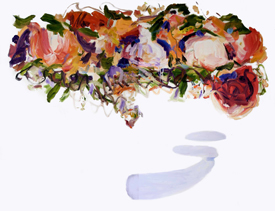 Stephen McClymont, Bouquet, 2013, oil on two linen panels, 77 x 102 in. (artwork © Stephen McClymont)
Stephen McClymont, Bouquet, 2013, oil on two linen panels, 77 x 102 in. (artwork © Stephen McClymont)
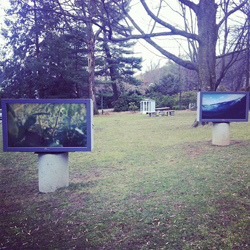 Lee Arnold, The Wanderer, 2013, digital color video, 3 min.; and The Swim, 2013, digital color video, 3:32 min. (artworks © Lee Arnold)
Lee Arnold, The Wanderer, 2013, digital color video, 3 min.; and The Swim, 2013, digital color video, 3:32 min. (artworks © Lee Arnold)
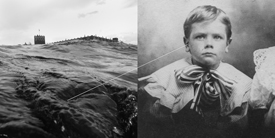 Anne Massoni, My Castle Striped Misery, 2010, archival digital print and hand-drawn painted line, 13 x 26 in. (artwork © Anne Massoni))
Anne Massoni, My Castle Striped Misery, 2010, archival digital print and hand-drawn painted line, 13 x 26 in. (artwork © Anne Massoni))
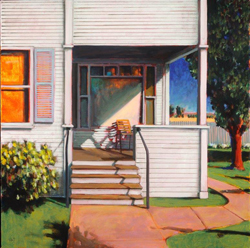 Sharon Wolpoff, Going Home, 2012, oil on linen, 34 x 34 in. (artwork © Sharon Wolpoff)
Sharon Wolpoff, Going Home, 2012, oil on linen, 34 x 34 in. (artwork © Sharon Wolpoff)
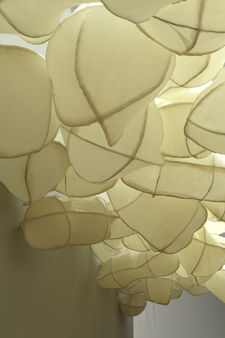 Lorrie Fredette, detail of Implementation of Adaptation, 2013, beeswax, tree resin, muslin, brass, nylon line, and wood, 288 sq. ft. (artwork © Lorrie Fredette)
Lorrie Fredette, detail of Implementation of Adaptation, 2013, beeswax, tree resin, muslin, brass, nylon line, and wood, 288 sq. ft. (artwork © Lorrie Fredette)

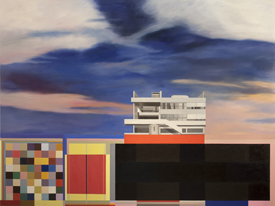 Julie Langsam, Le Corbusier Landscape (Villa Stein), 2013, oil on canvas, 72 x 96 in. (artwork © Julie Langsam)
Julie Langsam, Le Corbusier Landscape (Villa Stein), 2013, oil on canvas, 72 x 96 in. (artwork © Julie Langsam)
 Jerry Meyer, Ordinary Unhappiness, 2011, mixed media, 20¼ x 17¾ x 12 in. (artwork © Jerry Meyer)
Jerry Meyer, Ordinary Unhappiness, 2011, mixed media, 20¼ x 17¾ x 12 in. (artwork © Jerry Meyer)
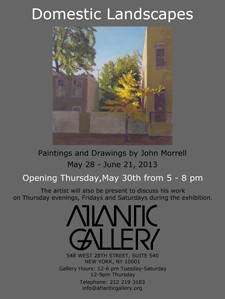 Invitation card for John Morrell’s Domestic Landscapes
Invitation card for John Morrell’s Domestic Landscapes
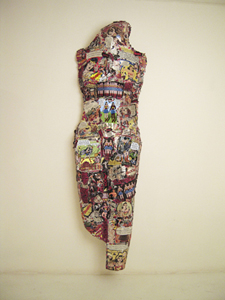 Linda Stein, Justice for All 698, 2010, acrylicized metallic paper, archival inks, and mixed media, 79 x 40 x 9 in. (artwork © Linda Stein)
Linda Stein, Justice for All 698, 2010, acrylicized metallic paper, archival inks, and mixed media, 79 x 40 x 9 in. (artwork © Linda Stein)
 Carol Ladewig, Year in Color: Lunar Phases, (52 Weeks and a Day), 2012, acrylic and gouache on 365 five-inch-square wood panels, 70 x 135 in. (artwork © Carol Ladewig; photograph by Phil Cohen)
Carol Ladewig, Year in Color: Lunar Phases, (52 Weeks and a Day), 2012, acrylic and gouache on 365 five-inch-square wood panels, 70 x 135 in. (artwork © Carol Ladewig; photograph by Phil Cohen)